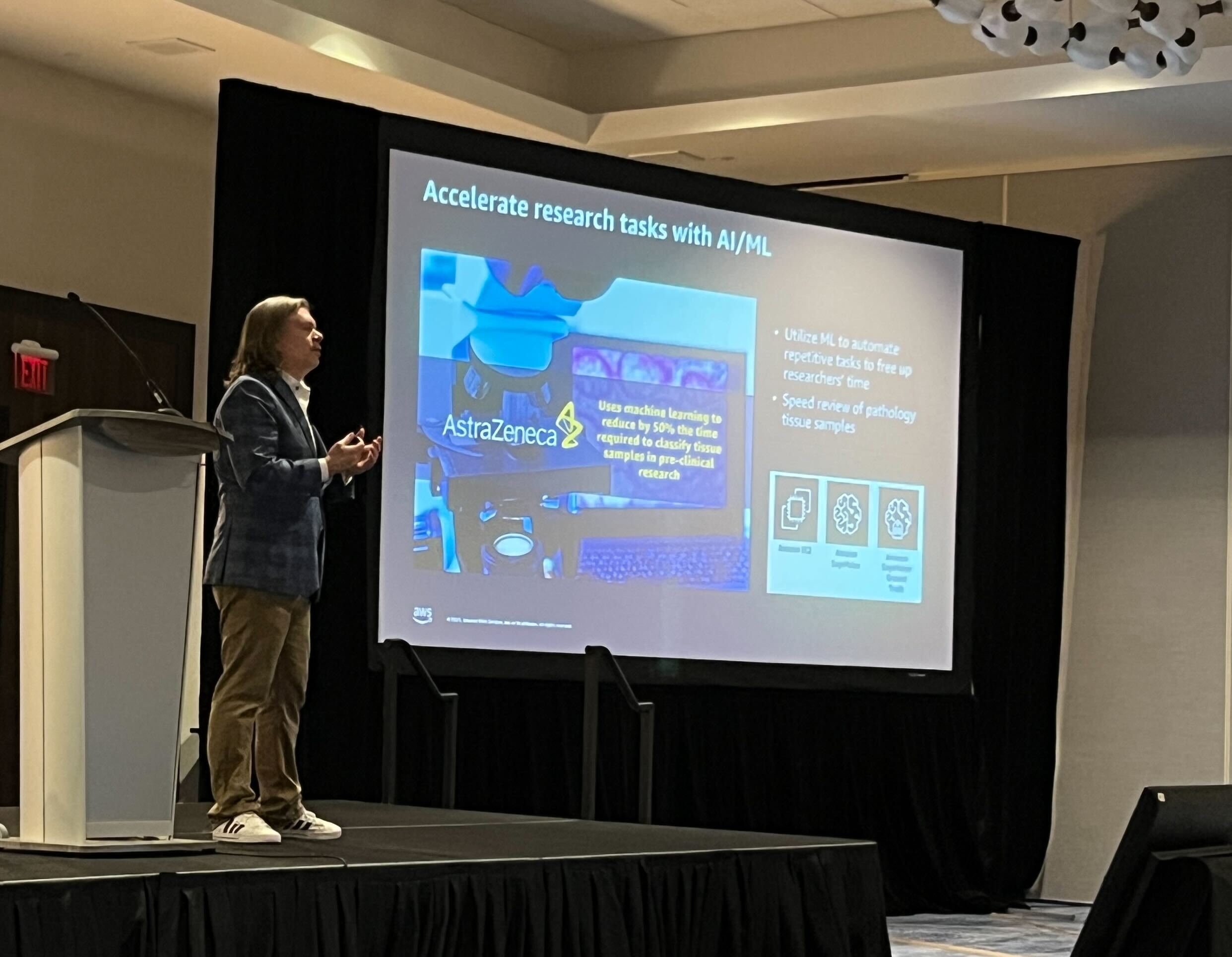At SapioCon 2025, conversations about AI and digital transformation took center stage, and no session underscored this more than the keynote presentation delivered by Ben Schreiner, Head of AI and Operator Data Strategy, Amazon Web Services (AWS). Schreiner outlined a vision for how AI and cloud technologies are reshaping scientific research, innovation, and healthcare.
His message was clear: Data and AI are revolutionizing the life sciences, compressing discovery timelines, and enabling scientists to focus on meaningful breakthroughs. But with these advancements come challenges—ensuring responsible AI deployment, maintaining data security, and addressing cloud transition concerns for regulated industries. Schreiner highlighted the partnership between AWS and Sapio, offering a glimpse into the future of AI-driven research.
The power of AI to transform scientific research
The role of AI in accelerating discovery
A most compelling insight for me was the way AI is compressing time in scientific research. Traditionally, drug discovery and development have taken years, even decades, but AI-driven tools can analyze vast datasets and generate insights in a fraction of the time. Schreiner likened AI to a force multiplier, accelerating innovation by eliminating the bottleneck caused by manual processes and enabling scientists to focus on the high-value aspects of their work.
More than anything, Schreiner emphasized AWS’s mission to help scientists do more, faster. “The work you do is incredibly important,” he said. “And all we want more than anything else is to help you do more of it, do it faster, so that you can solve some of these problems that you’re all trying to solve.” AWS’s commitment to the healthcare and life sciences sector is clear, with significant investments in infrastructure to support scientists and healthcare providers worldwide.
Data as the key to the success of AI
While AI holds immense potential, Schreiner emphasized that its effectiveness hinges on one fundamental factor: data order. AI models are only as powerful as the data they are trained on. And structured, high-quality data is critical for generating meaningful insights. This resonated with discussions throughout the event—without well-organized, structured data AI cannot deliver on its promises.
For many organizations, data remains fragmented across multiple systems, limiting the ability of AI to provide actionable insights. Schreiner stressed the need for companies to prioritize data governance, standardization, and integration to ensure that AI can work seamlessly across all scientific workflows. “We are hoarders of data,” Shriner joked, pointing out that AWS S3 storage now contains 400 trillion objects! This is a staggering number that illustrates the scale of modern data challenges.
Addressing the risks and challenges of AI
Hallucinations, validation, and compliance
One thing Schreiner confirmed for me was this: AI, for all its benefits, is not without risks. He acknowledged that AI-generated hallucinations—false or misleading outputs—pose significant challenges. In a highly regulated industry like pharmaceuticals, validation is crucial to ensure AI-driven insights are accurate and reproducible. He highlighted the need for robust AI models that prioritize transparency, fairness, and validation, especially as AI adoption scales.
Regulatory compliance is another major hurdle. With a staggering 57% of employees admitting to using public generative AI tools, Schreiner underscored the importance of providing trusted, organization-approved AI solutions. Without proper controls, sensitive research data could be exposed, leading to compliance risks and security breaches. AWS has responded by investing in highly secure, compliant cloud solutions, ensuring that organizations in regulated industries can leverage AI without compromising data integrity. Emphasizing this point, Schreiner noted, “The science is your big differentiator. Running data centers is ours. We invest way more than any of you possibly could in security and operational excellence.”
AWS and Sapio—Empowering scientists through AI and the cloud
One of the most exciting takeaways from Schreiner’s presentation was the growing collaboration between AWS and Sapio Sciences. The goal? To make it easier for scientists to do their best work by reducing technological friction.
Through this partnership, AWS and Sapio are tackling key challenges, including
- Enhancing AI-powered research tools to automate data processing and analysis.
- Addressing cloud adoption concerns for regulated organizations, ensuring compliance and security.
- Leveraging model distillation and edge computing to bring AI-driven insights directly to the lab.
Schreiner left me in no doubt that AWS sees itself as an enabler—a company that builds foundational technology so that partners like Sapio can continue to innovate. “We also want to help Sapio continue to innovate in the lab and push the envelope of what’s possible for the scientists that you all represent,” he explained. This sentiment echoes a broader theme of collaboration and mutual success, where AWS provides the infrastructure, and Sapio and other life sciences organizations drive scientific breakthroughs.
The emphasis on starting small and scaling up resonated throughout his presentation. Schreiner noted that organizations hesitant to adopt AI should begin with small-scale implementations, demonstrate value, and gradually expand adoption. This measured approach ensures that AI is integrated responsibly and effectively within scientific workflows.
The future of AI in life sciences
Schreiners’s keynote reinforced several essential lessons for organizations navigating AI adoption:
- AI is already transforming life sciences, but its success depends on structured, high-quality data. Companies must prioritize data order and governance to fully leverage the potential of AI. (To learn more about this, check out our latest whitepaper ‘Accelerating Digital Transformation in Biopharma R&D: Complex Science Needs Agile IT’)
- Security and compliance must remain top priorities. As AI adoption grows, organizations need robust controls to protect sensitive data and ensure responsible AI deployment.
- AWS and Sapio Sciences’ partnership is paving the way for AI-driven research efficiency. By combining Sapio’s expertise in laboratory informatics with AWS’s cloud and AI capabilities, scientists can work faster and more effectively.
- Organizations should embrace a gradual AI adoption strategy. Start small, refine workflows, and scale up as AI-driven efficiencies become clear.
- Healthcare is an end-to-end system, and AI has the potential to improve every stage of the journey. From early discovery to patient care, AWS is investing in solutions that make healthcare more data-driven, secure, and efficient.
AI is an enabler, not a replacement
A point that particularly struck me, as a passionate scientist, was Schreiner’s emphasis on AI as an enabler, not a replacement. The goal is not to replace scientists, but to free them from tedious, manual tasks so they can focus on groundbreaking discoveries.
AWS’s $100 billion investment in AI and infrastructure this year, alongside its $8 billion sovereign cloud initiative, underscores its long-term commitment to this mission. By ensuring that compute capability is available where and when it’s needed, AWS is helping global life sciences organizations navigate complex regulatory environments while staying a the forefront of innovation.
As AI and cloud technologies continue to evolve, organizations that invest in trusted, secure, and well-integrated AI solutions will lead the next wave of scientific breakthroughs. The future of the life sciences isn’t just digital. It’s AI-powered. And with strategic partnerships like that between AWS and Sapio Sciences, that future is closer than ever.





